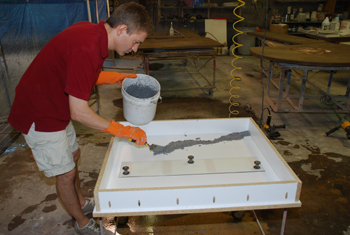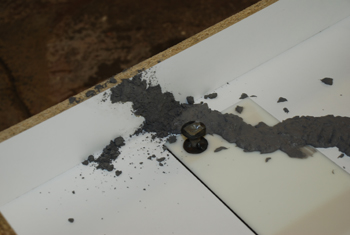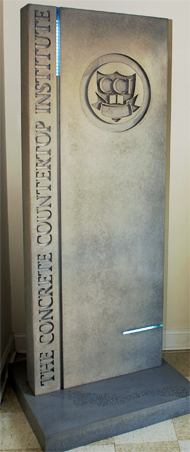There are three basic methods for embedding aggregate into GFRC, all of which result in different looks and require different materials or equipment.
In the explanations below, the first layer that is placed or sprayed in the forms is called a “face coat” if it contains aggregate, and a “mist coat” if it does not contain aggregate.
1. Aggregate secured in empty forms using spray adhesive
Method number one for creating a face coat is to cast loose aggregate into the empty forms, then pour, trowel or spray a thick mist coat over the aggregates. To prevent the aggregates from being pushed around, use spray adhesive applied to the forms prior to placing the loose aggregate. The disadvantage of this method is that voids are likely to form around the aggregates because it is difficult to fully encapsulate them with mist coat.
2. Aggregate secured in forms using mist coat
The second method is to first spray, pour or trowel a thin mist coat down instead of using spray adhesive. The advantage of this is the aggregate is more likely to be fully encapsulated with fewer voids forming around the aggregates.
3. Aggregate is mixed with mist coat to create a face coat
A third alternate method is to mix the aggregate into the mist coat and then A. trowel, B. pour/hand pack or C. spray the resulting face coat into the forms. This gives the most realistic look and best encapsulation of the aggregate.
Option B– However, troweling or hand packing this stiffer face coat on vertical surfaces tends to leave more voids in the concrete than when it’s placed on horizontal surfaces, since the face coat is made more fluid when it is intended to be placed on horizontal surfaces than when it is intended to be placed on vertical surfaces. (When you’re planning to place concrete on vertical surfaces, you use less superplasticizer so that it will be stiffer and not run down the vertical surface.) This results in inconsistent looks between the vertical and horizontal surfaces of your countertop. However the voids on the vertical surface tend to be smaller than when the aggregate is first placed dry into empty forms as in method number one.
Placing a “river” of face coat with glass in a form that will have a traditional mist coat sprayed around it
Note the difference in texture of the face coat that was placed on the horizontal surface (it used superplasticizer for fluidity) and the face coat that was placed on the vertical surface (it had to be very stiff to stick to the surface and not slump down).
By the way, this piece was the base for a 6 foot tall concrete sign. I cover the entire fabrication process, including how I built the mold and made the letters, plus several other 3-dimensional pieces, in this seminar.
Option C– Spraying a mist coat is possible, but only if you have a real GFRC spray machine, because only aggregate smaller than 1/8″ can pass through most hopper guns. When spraying a face coat, lower the air pressure driving the spray out of the gun. Higher velocities will cause larger particles to bounce out of the form instead of staying embedded in the face coat.
In all three methods, you need to grind to expose the aggregate. In method number one, the amount of grinding will be the least, since the aggregates are already placed the closest to the visible surface of the concrete.



